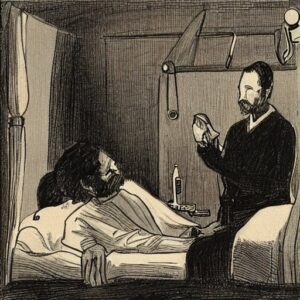Introduction to Near Death Experiences
Near-Death Experiences (NDEs) have been a subject of fascination and debate for decades. NDEs are experiences that some people report having after a close brush with death, such as during a heart attack, accident, or other life-threatening events. In this article, we will explore the science behind NDEs, their common features, the criticisms and skepticism they face, and their potential implications for our understanding of life after death.
A brief explanation of the concept of Near-Death Experiences (NDEs)
Near-Death Experiences (NDEs) are a fascinating and mysterious phenomenon that has captivated people’s imagination for centuries. NDEs occur when a person is on the brink of death, and they report a range of vivid and life-changing experiences, such as encounters with deceased loved ones, out-of-body experiences, and even trips to other realms of existence.
The importance of studying NDEs
The study of NDEs is crucial because it offers unique insights into the nature of consciousness, the afterlife, and the human experience. By examining the accounts of people who have undergone NDEs, researchers can gain a better understanding of the brain, consciousness, and the mysteries of existence itself.
The purpose of the article
The purpose of this article is to provide an overview of what science says about NDEs, including the latest research findings and theories. By the end of this article, readers will have a better understanding of what NDEs are, what causes them, and what they may reveal about the nature of life and death.
The Science Behind NDEs
Near-Death Experiences (NDEs) have been a topic of scientific inquiry for decades. Researchers from various disciplines, including psychology, neuroscience, and philosophy, have sought to understand the phenomena behind NDEs. In this section, we’ll explore the history of NDEs as a subject of scientific inquiry, the different theories about the causes of NDEs, and the evidence supporting the existence of NDEs.
A. History of NDEs in Scientific Inquiry
The scientific study of NDEs began in the late 19th century when physicians and psychologists began to document the experiences of patients who had survived life-threatening experiences. The first formal study of NDEs was conducted in 1968 by psychiatrist Raymond Moody, who coined the term “Near-Death Experience.” Since then, numerous studies have been conducted on NDEs, and the topic has garnered increasing attention in the scientific community.
B. Theories about the Causes of NDEs
There are several different theories about the causes of NDEs. Some researchers believe that NDEs are a result of physiological processes in the brain, while others propose psychological or spiritual explanations.
- Physiological Explanations
Some researchers suggest that NDEs are a result of physiological processes in the brain. For example, they propose that a lack of oxygen to the brain, or the release of certain chemicals in the brain during times of stress, can trigger NDEs. This theory is supported by research that shows similarities between NDEs and other altered states of consciousness, such as drug-induced hallucinations.
- Psychological Explanations
Other researchers propose that NDEs are a result of psychological processes, such as the brain’s attempt to cope with the stress of a life-threatening event. Some suggest that NDEs are a type of dissociative experience, where the individual feels detached from their physical body.
- Spiritual Explanations
Finally, some researchers propose that NDEs are evidence of an afterlife or spiritual realm. They suggest that NDEs are a glimpse into a reality beyond the physical world and that the experience is a manifestation of the soul’s journey after death.
C. Evidence Supporting the Existence of NDEs
Despite the varied explanations for NDEs, there is a growing body of evidence that suggests that the phenomenon is real. Studies have shown that individuals who have had NDEs report similar experiences, regardless of their cultural or religious background. In addition, some studies have found physiological changes in the brain during NDEs, such as increased activity in the areas responsible for visual processing and memory.
Overall, while the causes of NDEs are still not fully understood, there is compelling evidence that NDEs are real and meaningful experiences. Continued research in this area could provide insight into the nature of consciousness, the afterlife, and the human experience.

Common Features of NDEs
Near-death experiences are often characterized by a set of common features that are reported across cultures and religions. These features can include:
- Out-of-body experiences: Many individuals who have had an NDE report feeling as though they have left their physical body and are observing the world from a different vantage point. This can be a disorienting experience, but is often described as feeling peaceful and freeing.
- Tunnels of light: Another common feature of NDEs is the experience of traveling through a tunnel of light. This tunnel is often described as being warm and inviting, and may lead to an encounter with a being of light or deceased loved ones.
- Encounters with deceased loved ones: Speaking of deceased loved ones, many individuals who have had an NDE report encountering friends or family members who have passed away. These encounters can be emotional and provide a sense of comfort and reassurance.
- Life review: Some individuals report experiencing a “life review” during their NDE, in which they relive important moments from their past. This review is often described as being non-judgmental and providing a sense of perspective on one’s life.
The differences in NDEs across cultures and religions
It’s worth noting that while these features are commonly reported, the specifics of each individual’s NDE can vary greatly. For example, the tunnel of light may look different for different people, or some individuals may not have an encounter with deceased loved ones at all.
Additionally, there are some cultural and religious differences in the way that NDEs are experienced and interpreted. For example, some individuals from non-Western cultures may report encountering different types of beings during their NDEs than those reported by Western individuals.
Overall, the common features of NDEs provide a fascinating insight into the human experience of death and dying, and highlight the importance of continued research in this area.
Skepticism and Criticisms of NDEs
Despite the growing scientific evidence supporting NDEs, there are still skeptics who challenge the validity of the phenomenon. Here are some common arguments against NDEs and the counterarguments and evidence supporting them.
A. Skepticism
- NDEs are just hallucinations or delusions caused by the brain under stress.
- NDEs are merely a byproduct of certain medical treatments, such as anesthesia or drugs.
- NDEs are culturally specific and therefore not a universal phenomenon.
- NDEs are a result of wishful thinking and the desire to believe in an afterlife.
B. Counterarguments and Evidence
- NDEs are not consistent with hallucinations or delusions as they often involve accurate perceptions of the physical environment.
- NDEs have been reported by people who have not undergone medical treatment or had any drugs administered.
- While the cultural and religious context may influence the interpretation of NDEs, the core features remain the same across cultures and religions.
- Studies have shown that people who have had NDEs do not have a stronger belief in an afterlife than those who have not.
NDEs and Life After Death
Near-death experiences (NDEs) have often been linked to the concept of life after death, as many people who experience NDEs report encountering deceased loved ones or feeling a sense of being outside of their body. This has led many to speculate that NDEs provide evidence of an afterlife or an existence beyond the physical body.
The relationship between NDEs and the afterlife is a topic of ongoing debate and research. While some argue that NDEs are proof of an afterlife, others maintain that NDEs are simply a result of physical and chemical changes in the brain that occur during a near-death experience.
Despite this debate, NDE research has had significant implications for our understanding of the afterlife. For example:
- NDEs have challenged traditional religious beliefs about the afterlife, as people from different cultures and religions report similar experiences during NDEs.
- NDEs have led to increased research into consciousness and the nature of reality, as scientists and philosophers seek to understand how consciousness can exist outside of the physical body.
- NDEs have provided comfort and solace to people who have lost loved ones, as they offer a sense of hope that death may not be the end.
Overall, NDE research has opened up new avenues for exploring the relationship between the physical body, consciousness, and the afterlife. While much remains unknown, continued research in this area has the potential to shed light on some of life’s biggest questions.
Conclusion
As we have seen, Near-Death Experiences (NDEs) have been the subject of scientific inquiry for several decades, with researchers from different fields exploring their causes and implications. Despite some skepticism and criticism, there is mounting evidence to suggest that NDEs are a real phenomenon that can have a profound impact on those who experience them.
The common features of NDEs, such as out-of-body experiences and encounters with deceased loved ones, provide some tantalizing clues about the nature of consciousness and the possibility of life after death. Moreover, NDE research has the potential to challenge some of our most deeply held beliefs about the nature of reality and the meaning of life.
Given the significance of NDEs, it is crucial that we continue to study them with an open and rigorous scientific mindset. By doing so, we can gain a better understanding of the mysteries of life, death, and the afterlife, and perhaps even uncover new avenues for personal growth and spiritual development.
If you want to learn more about Near Death Experiences, the documentary The Final Frontier is an interesting documentary to watch.

The Final Frontier
Documentary, Dramatization
